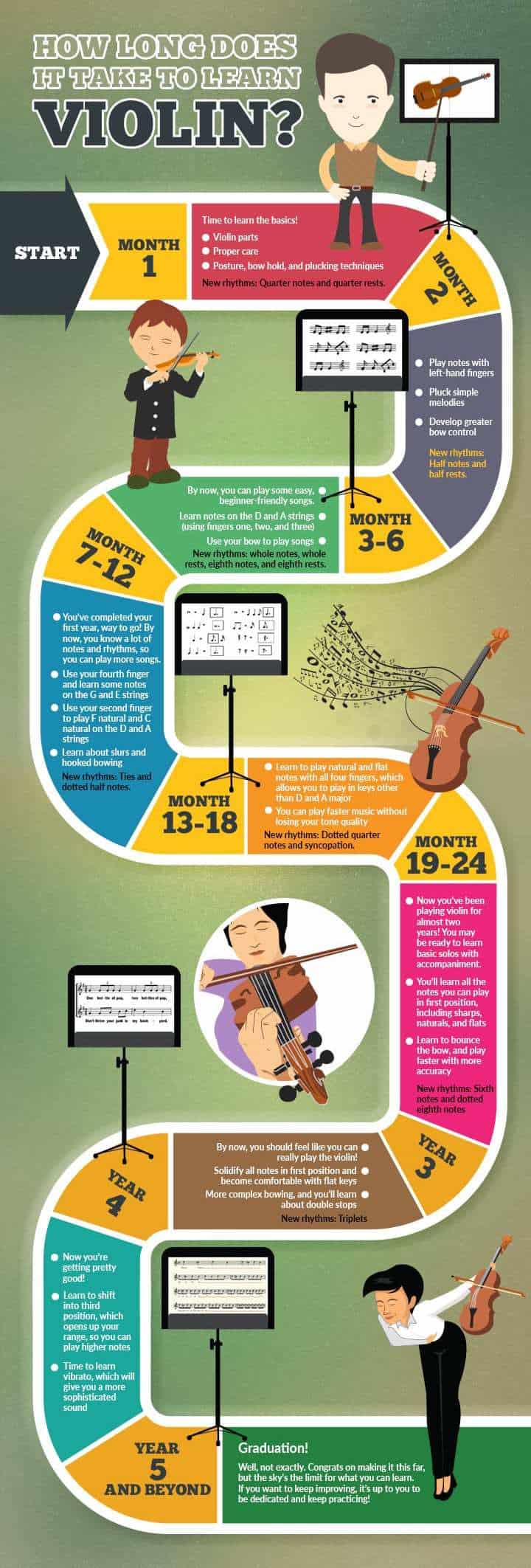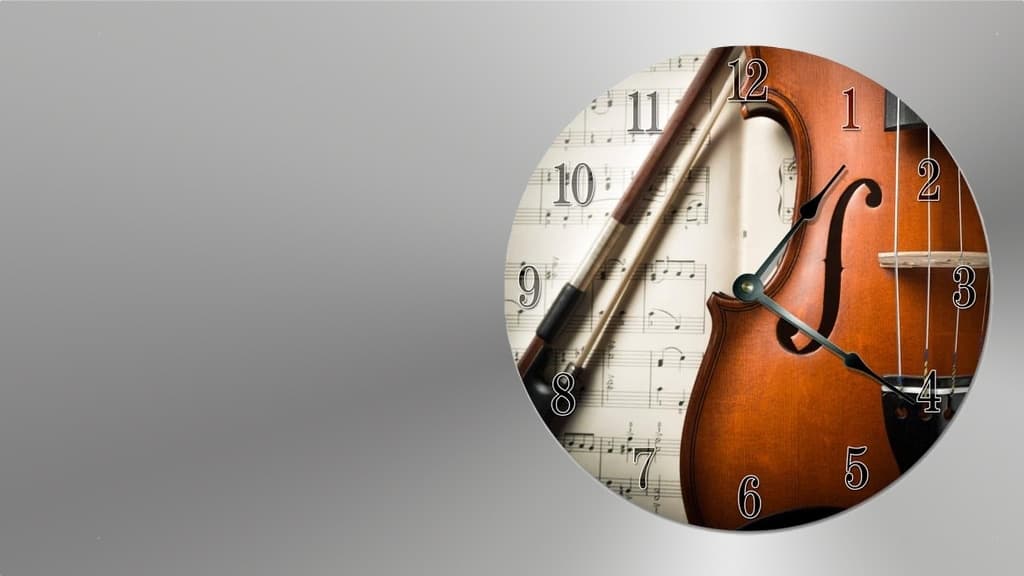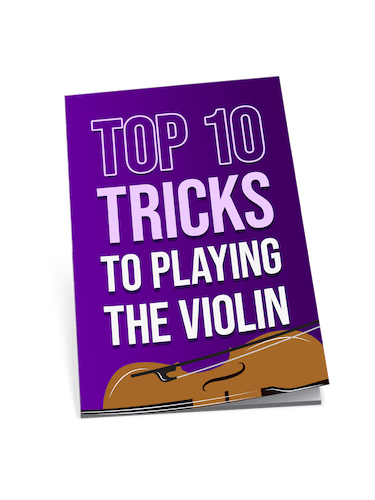How long does it take to learn the violin? Well, I guess that depends on how much work you’re happy to put in… Violinist Jamie Hutchinson has just finished a recording session at Abbey Road Studios, and she can tell you all about it using her 300-year-old Italian violin to demonstrate.
So how long does it take to learn violin?
Anyone can learn to play the violin, at any age. Yes, the older you get, the slower you understand, but it doesn’t mean that it can’t be done. Everyone learns at a different speed, and each human has a diverse skill set, so it could take you three years to play Bach – or it could take you thirty.
That’s the short answer, but of course, there is a bit more to it.
Your learning speed entirely depends on how much you practice. If you would like to become a great violinist, you’ll have to work hard. Learning is a lifelong journey. It’s a road that never ends. But that’s part of the fun!
Timeline of learning
First few months
The first few months of lessons are spent trying to understand the basics. Learning to play an instrument, and learning to read music are two entirely different skills. Usually, a person finds one of those skills easier than the other.
You’ll learn how to look after your violin, and work on fundamental techniques like:
- Posture
- Bow hold
- Plucking
You’ll also start learning a couple of simple scales and the relevant music theory.
First-year
After a year of playing violin, you should be able to play a few tunes and songs that you’re proud to perform. You should have a good foundational understanding of the instrument, how it works, and how to look after it.
Your bowing technique should by now feel comfortable, and your understanding of the notes on the violin should be reasonably secure.
Two to three years
After two to three years of learning, your technical abilities should have increased massively. Hopefully, you’ll also be able to read music by now without having to ‘think about it’ too much. Eventually, reading musical notation becomes second nature; and when that happens, life becomes a lot easier!
Four to five years
You’ll be learning to shift into third position, and also start using vibrato as a technique to give greater musical expression. You’ll also be working more on scales and studies.
Six years and beyond
The world is your oyster (I know, I never understood that phrase either!). By now, you should be reasonably competent enough, and have enough natural personal skills, to be able to push forward your playing without relying 100% on your teacher. Students, after all, only spend 5% of their time in lessons; 95% of the time is with the best instructor you know – you!

PLAYING REQUIRES PATIENCE
Playing any musical instrument is about long term dedication and patience. Violin students try and schedule their practice sessions every day. They have found the most fantastic violin teacher, and so look forward to violin lessons. They understand that learning the violin to a high standard can take many years. They know that progress is about the bite-size chunks of success that take place every day whilst you play the violin – it’s not about an end goal. It’s about thousands of mini-goals en route.
There are some key things you can do, which can make a massive difference:
Violin Lesson
Learning the violin requires finding someone who can share their love of the instrument and teaching with you. The majority of people fail at their instrument, not because they don’t enjoy violin playing, but because their teacher doesn’t inspire them. Teachers are an essential part of learning. Find a great teacher, and half your battle is won.
Practice
For all violinists, practice is the most critical part of progress. Concentrate on separating our elements of music-making. Rhythms. Fingers. Left-hand isolation work. Vibrato. These are all techniques that need dedication. For more help on practice, do take a look at our How to practice the violin article.
Progress Monitoring
You wouldn’t build a house without monitoring the progress of the project. You’d be checking in with all the workmen that they are doing a proper job. You need to do the same for your violin playing. Check-in with yourself regularly. Don’t just fall into the auto-pilot trap of ‘playing the violin’. Practice time is a skill to be learnt and monitored.
Bow hold
Your bow is just as important than the violin itself. Look after the bow hair, and make sure you have some great rosin on hand at all times. Practice your bow hold until it feels entirely natural for you. Your hold technique can help or hinder how long it takes to learn. And remember to keep a spare set of violin strings in your case, just in case!
Sheet Music
Occasionally grab some sheet music you’ve never seen before, and try to play it. This sight-reading will come in handy when you’re technically secure on the instrument. The people who can sight-read on their instruments are always the ones who excel.

Summary
If you want to play violin, you need to understand that lessons and practice equal ability. A beginner musician should take the view that they’ll enjoy playing for many years. It’s not a race. Instruments all over the world are being plucked, hit, blown and bowed. The trick is to play regularly, and you’ll soon see your skill develop.
We hope you have found this motivating, if so then your next step should be to read our dedicated beginner’s guide to learning the violin, which can be found here.
Let us know in the comments below if you liked the video.
FAQ's
Malcolm Gladwell once said that to become an expert or master an instrument, you need 10,000 hours of practice. It is, however, completely wrong. Find out why in this article.
It is. But it’s not impossible. If it were easy, it wouldn’t be as enjoyable. So if you are thinking about playing, read our Beginner’s Guide to Learning the Violin to help.
You can do, but you shouldn’t. Learning is about sharing knowledge and experience. You’ll remain a beginner learner for much longer if you and inexperience unknowledgeable person tries to teach yourself. Instead, find a tutor, and then absorb all their skill.
Most people start learning at the age of four at the youngest. I have taught people who are in their nineties. So age is (almost) irrelevant. It doesn’t, however, mean that everyone learns at the same speed!
DID YOU LIKE THE VIDEO -
How long does it take to learn the violin?


Did you make a comment below the video? If you forgot, no worries! Just click here to comment below…











I’ve been looking for something like this to help me understand what my kiddo is going through with her violin lessons. It’s easy to get impatient as a parent, wanting to see quick progress. This article really puts into perspective the kind of time and dedication required. Helps me set my expectations right and find ways to support her better. Any tips on encouraging daily practice without turning it into a chore?
Six years and beyond, huh? Seems like an eternity to master an instrument. Makes me wonder if it’s worth all that time and effort. I mean, how many actually stick with it for that long without giving up? Just thinking out loud here.
Totally digging this article! Been at it with the violin for about a year now and it’s been tough but so rewarding. Learning the bow hold felt impossible at first, but now it’s getting smoother. Your section about patience really hits home. It’s a long road but articles like this make me feel like I’m not walking it alone. Cheers!
Right there with you! The bow hold was a nightmare for me too, but we’re getting there. Hang in there, mate. We’ll be making beautiful music before we know it!
An informative article that provides a realistic timeline for violin learners. One aspect that merits further discussion is the transition from reading sheet music to playing by ear. Mastering sheet music is paramount, but the ability to play by ear enhances musicality and adaptability. Perhaps a segment on incorporating ear training early in the learning process would be beneficial for readers.
Hey, just started my journey with the violin and it’s been a ride. Sometimes, it feels like progress is super slow. Really appreciate the breakdown by years, gives me some kind of roadmap. What I’m wondering is how many hours a day would you recommend for practice in the first few months? Is there like a sweet spot where it’s enough but not too much that it becomes overwhelming? Thanks for the insights!
Ooh, that sounds quite intriguing. It never crossed my mind that after training for half a year we would be able to play some basic tunes using our violin. One of my nephews is interested to become a part-time violinist when he enters college next year. For me, to achieve such a result he needs to find an instructor to guide him properly.
I had just bought my son a violin and I was not looking forward to the first few months of practice but looking through this article, I should be hearing lovely music soon.
Remain positive! He won’t be playing Vivaldi in the next few months, but we all have to start somewhere! 🙂